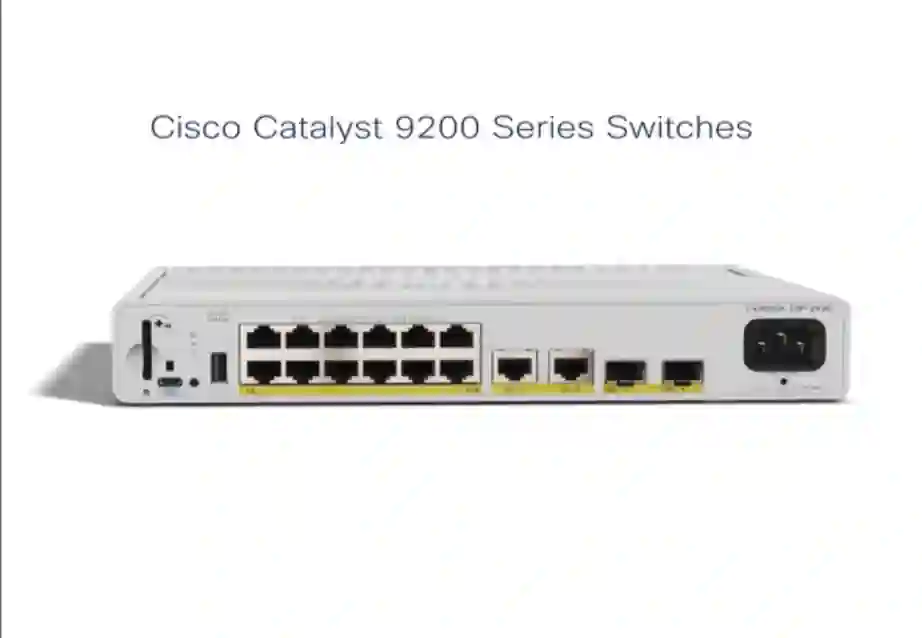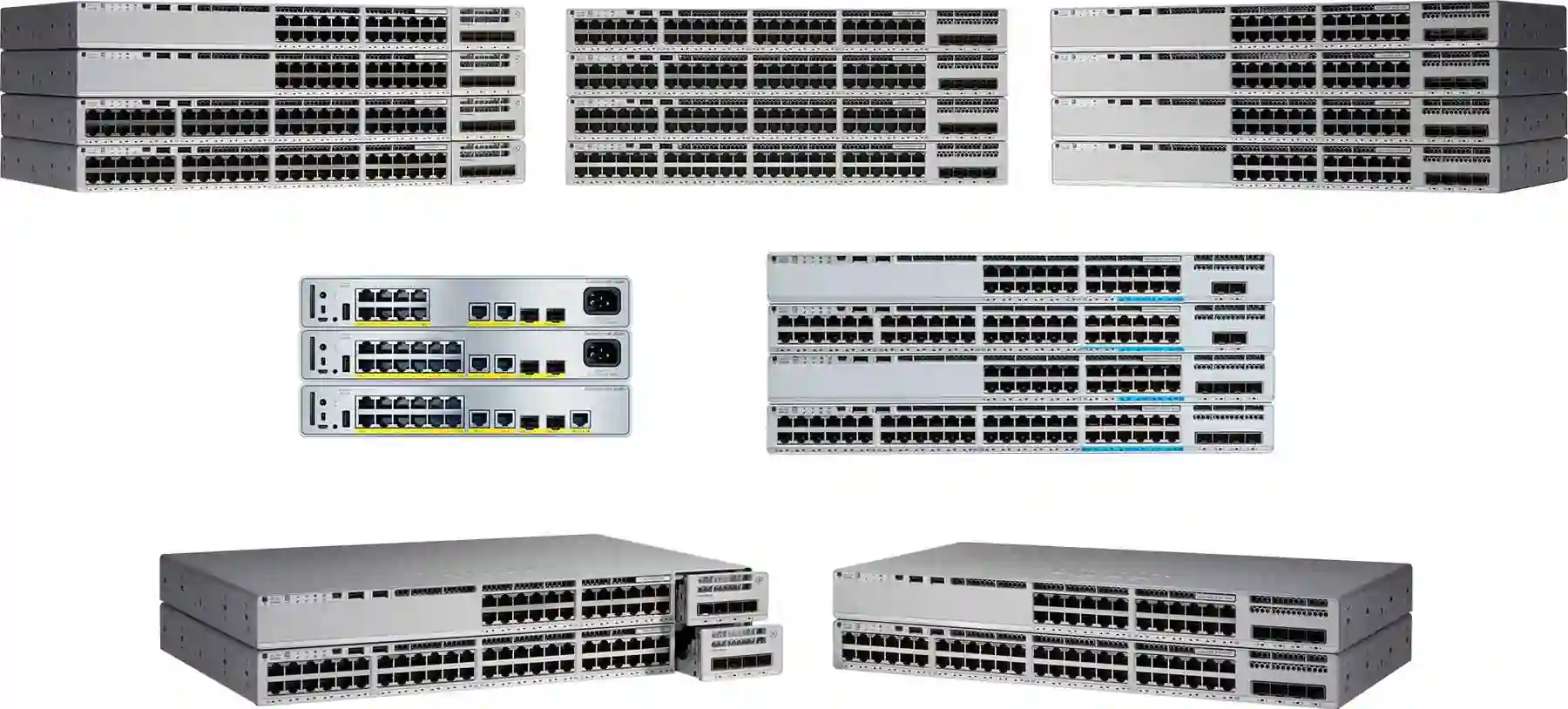Picking the right access switch is a big deal for keeping your network zippy and safe. Cisco Catalyst 9200 Series and HPE Aruba Networking CX 6000 are two heavy hitters. But which one’s the champ for your enterprise? Let’s dig into their perks, quirks, and real-world fit to find out. At Huaying Hengtong, we’re all about helping you choose the perfect gear.
What Sets the Cisco Catalyst 9200 Series Switches Apart in Today’s Network Demands?
Key Features That Support Modern Enterprise Environments
Cisco Catalyst 9200 Series switches are built to tackle today’s wild network needs. They’re ready for intent-based networking. That means they’re smart and flexible. They handle full Layer 2 tasks. Also, some Layer 3 tricks. Models like C9200-24T-E, C9200-48P-A, and C9200L-48T-4X-E come with modular uplinks. They’ve got backup power and fans for nonstop work.
With StackWise-160, they pump out up to 160 Gbps stacking bandwidth. That’s serious speed for growing networks. They support fancy routing like OSPF, EIGRP, and static routing. Perfect for big, complex setups.
How Cisco Catalyst 9200 Series Switches Enhance Security and Reliability
Security’s a big win with Cisco Catalyst 9200. These switches pack Trustworthy Solutions. Think Secure Boot, image signing, and runtime defenses. They keep bad stuff out. They also use MACsec encryption to lock down data over Ethernet links.
They play nice with Cisco DNA Center. That lets you use Software-Defined Access (SD-Access). It splits your network by policies for wired and wireless. Keeps your data safe. Keeps your work smooth.
Why Cisco Catalyst 9200 Series Switches Are Built for Operational Simplicity
These switches make life easy. They support Zero-Touch Provisioning (ZTP). That means a plug-and-play setup across multiple sites. No fuss. They’ve got a slick web UI. Plus, they’re programmable with open APIs like NETCONF and RESTCONF.
Cisco DNA Center is the star here. It handles management, monitoring, and fixing issues from one dashboard. Cuts down on IT headaches big time. You get more control with less work.

Can HPE Aruba Networking CX 6000 Compete with Cisco Catalyst 9200 Series Switches?
Core Capabilities of HPE Aruba Networking CX 6000 in Enterprise Networks
HPE Aruba Networking CX 6000 is a solid pick for small to mid-sized businesses. It’s great for branch offices too. It focuses on basic Layer 2 switching. Some models add limited Layer 3 static routing. They run on Aruba’s AOS-CX operating system. That keeps things consistent across Aruba’s switch lineup.
They offer VLAN segmentation. Also, QoS policies are used to prioritize traffic. Basic security, like port security and DHCP snooping, keeps things safe. Aruba Central’s cloud-based management lets you watch your network remotely. It’s simple and handy.
Where HPE Aruba Networking CX 6000 May Fall Short in Large-Scale Deployments
The CX 6000 is great for smaller setups. But it can stumble in big, critical networks. It lacks advanced routing like OSPF or EIGRP. Most models don’t have MACsec encryption built-in. That’s a bummer for high-security needs.
Stacking? It’s limited compared to Cisco’s StackWise tech. If you need serious scaling, it might not keep up. Also, Aruba Central is cool, but doesn’t match Cisco DNA Center’s deep automation for huge networks. You might need extra Aruba tools for a full zero-trust setup.
How Do Cisco Catalyst 9200 Series Switches and HPE Aruba Networking CX 6000 Compare in Real-World Scenarios?
Performance and Scalability Differences Between the Two Platforms
In big campus networks or multi-site setups, Cisco Catalyst 9200 takes the lead. Its StackWise-160 delivers 160 Gbps stacking bandwidth. Models like C9200L-48T-4X-E support up to four 10G uplinks. That’s plenty of juice for heavy traffic.
Aruba CX 6000 has fixed uplinks. Usually 1 GbE. Some models hit 10 GbE, but it’s less flexible. For massive networks needing high-speed links, Cisco’s modular design wins. It scales better for growing demands.
Security Architecture: A Side-by-Side Comparison
Cisco’s security is top-notch. It uses hardware-based Trust Anchor modules. That means secure boot and runtime defenses. MACsec encryption locks down data tightly. SD-Access through Cisco DNA Center adds policy-based splits for wired and wireless.
Aruba CX 6000 covers the basics. Think ACLs and DHCP snooping. But it misses deeper zero-trust features unless you add other Aruba products. For high-security setups, Cisco’s got the edge.
Management Tools and User Experience: Which Offers Greater Efficiency?
Cisco DNA Center is a game-changer. It’s a single hub for automation, analytics, and policy enforcement. It handles software updates and troubleshooting, too. With REST APIs and telemetry, you get clear network views at scale.
Aruba Central is cloud-based and user-friendly. It’s great for smaller teams. But it lags in deep automation for big networks. Cisco’s tools handle complex setups better. They save time and reduce errors.
Why Are More Organizations Choosing Cisco Catalyst 9200 Series Switches?
The Role of Automation and Policy-Based Configuration
Automation’s a must these days. Cisco Catalyst 9200 shines with intent-based networking via DNA Center. You set business policies, not manual CLI configs. That cuts mistakes. Speeds up rollouts across sites. SD-Access applies user roles across wired and wireless. Makes policy enforcement a breeze.
Support for Hybrid Workforces and Remote Connectivity Needs
Hybrid work is everywhere. Cisco Catalyst 9200 handles it like a pro. MACsec encryption keeps data safe at the hardware level. SD-Access extends to VPNs and SD-WANs. It splits traffic by user identity, not just IP. That simplifies security for home offices or branches. Your remote team stays connected and secure.
Long-Term Investment Value of Cisco Catalyst 9200 Series Switches
Cisco’s known for long-lasting support. That’s gold for total cost of ownership (TCO). Models like C9200-24P-E have modular designs. You can upgrade without swapping whole units. DNA Center’s software updates keep you current without new hardware. It’s a smart buy for the long haul.

Who Is Huaying Hengtong, and How Do We Help You Choose the Right Access Switch?
Our Commitment to Professional Network Solutions
Huaying Hengtong kicked off in 2016 with 30 million yuan in capital. We sell and service brands like DELL, HPE, Lenovo, Inspur, Huawei, Super Fusion, and H3C. Our North China network is huge. Over 100 pros handle sales and support. We’ve built a rock-solid channel over ten years. Ready to power your network.
Services We Provide Around Cisco Catalyst 9200 Series Switches
We’ve got a deep lineup of network gear. Including Cisco Catalyst 9200 Series switches. Our team picks the right fit for your setup. From tiny offices to sprawling campuses. We tailor solutions to your needs. You get gear that works for you now and later.
How We Assist Clients in Deployment, Maintenance, and Technical Support
We’re with you from start to finish. From picking equipment to setting it up. We analyze your needs. Verify tech. Choose the best gear. Our crew ensures smooth rollouts. We offer ongoing monitoring and quick-fix support. Problems pop up? We’re on it fast. Our goal? Be China’s top IT service provider.
FAQ
Q: What factors should I consider when choosing an access switch?
A: Evaluate your network size, required bandwidth per port (e.g., Gigabit vs multigigabit), PoE needs for connected devices like IP phones/cameras/access points, and whether you need Layer 3 routing features or just Layer 2 switching capabilities.
Q: How important is switch stacking capability?
A: Stacking allows multiple physical switches to operate as one logical unit, simplifying management while enabling higher bandwidth between devices, crucial in scalable enterprise deployments where uptime matters most.
Q: What makes a switch suitable for hybrid work environments?
A: Look for integrated security features like MACsec encryption or identity-based segmentation along with remote management tools that allow centralized control over dispersed endpoints, including branch offices or home users.
Q: Can cloud-managed switches replace traditional on-premise managed ones?
A: Cloud-managed switches offer flexibility but may lack deep integration into existing infrastructure; organizations must assess whether they need advanced automation/policy controls typically found in platforms like Cisco DNA Center before choosing cloud-first options.
Q: Is investing in advanced switch models worth it long term?
A: Yes—models supporting modular upgrades or enhanced software capabilities often reduce future upgrade costs while ensuring compatibility with emerging technologies like Wi-Fi6/SD-WAN/cloud-native applications.











